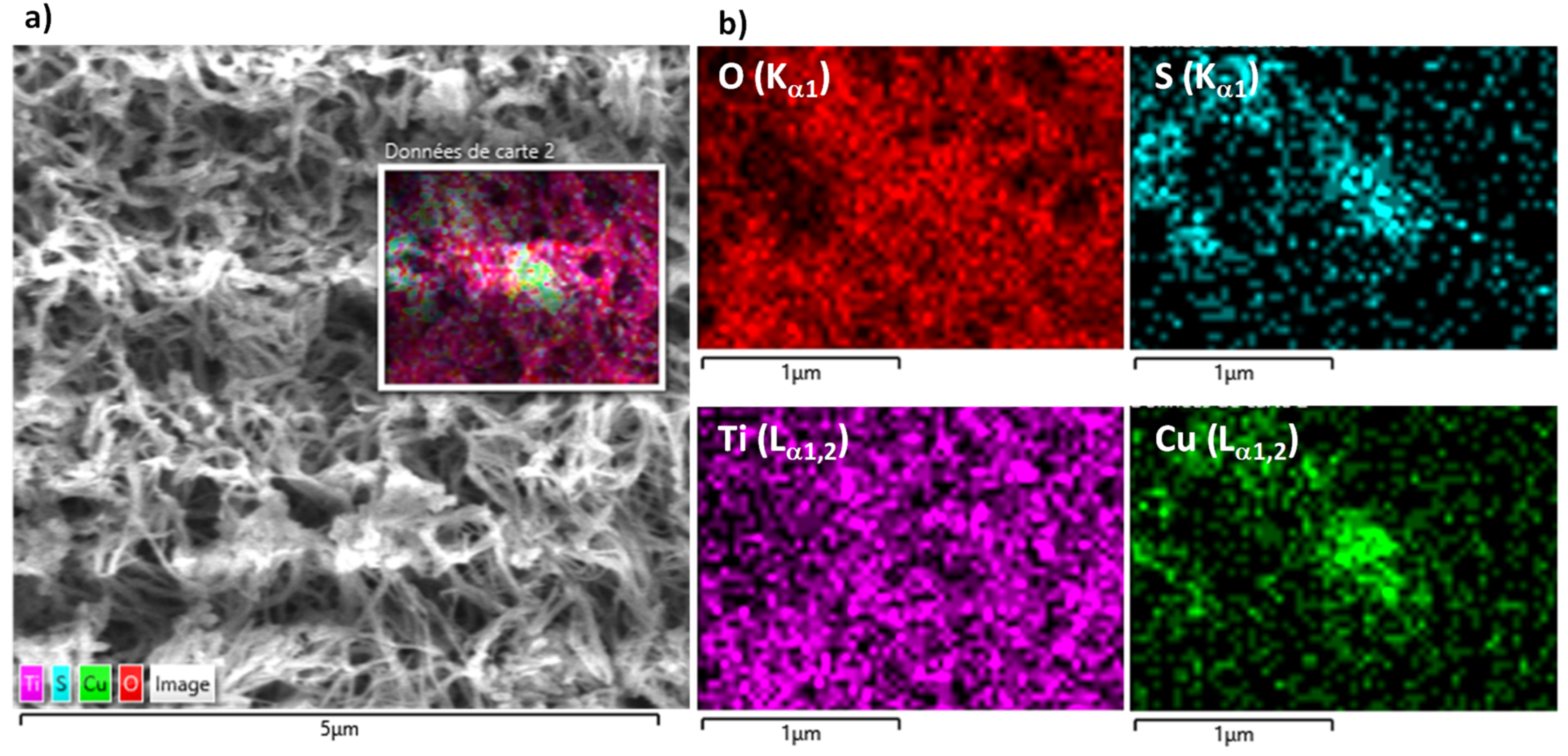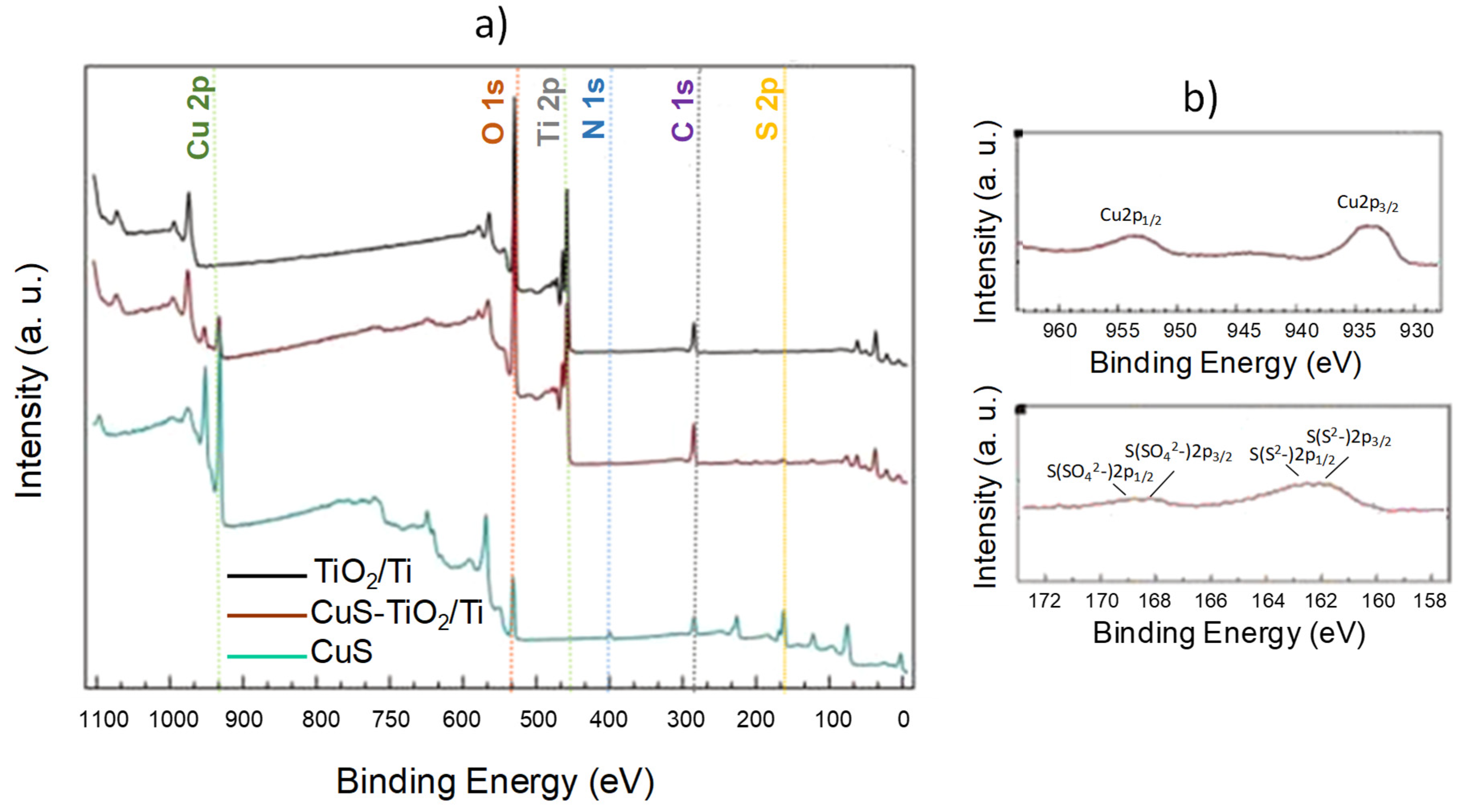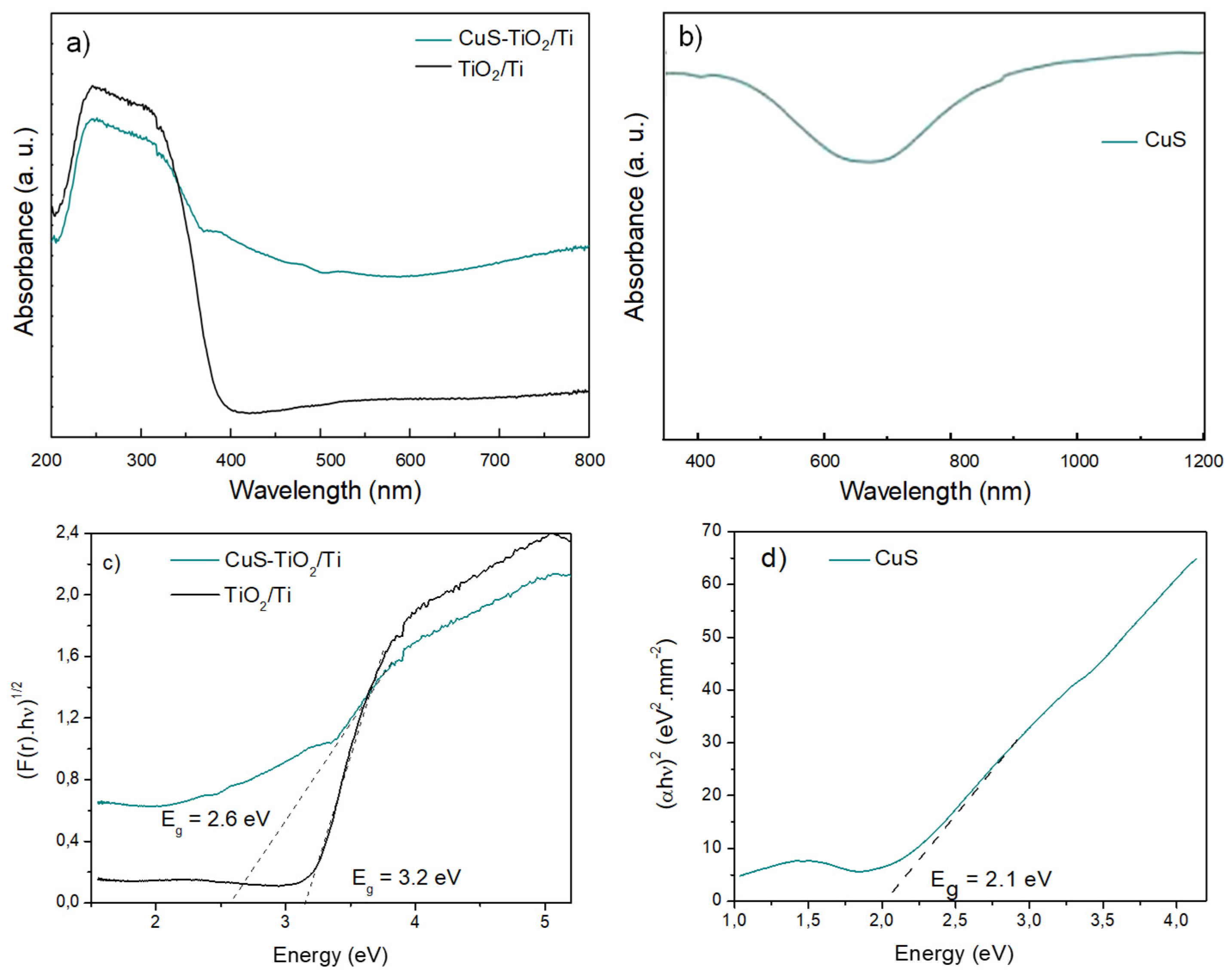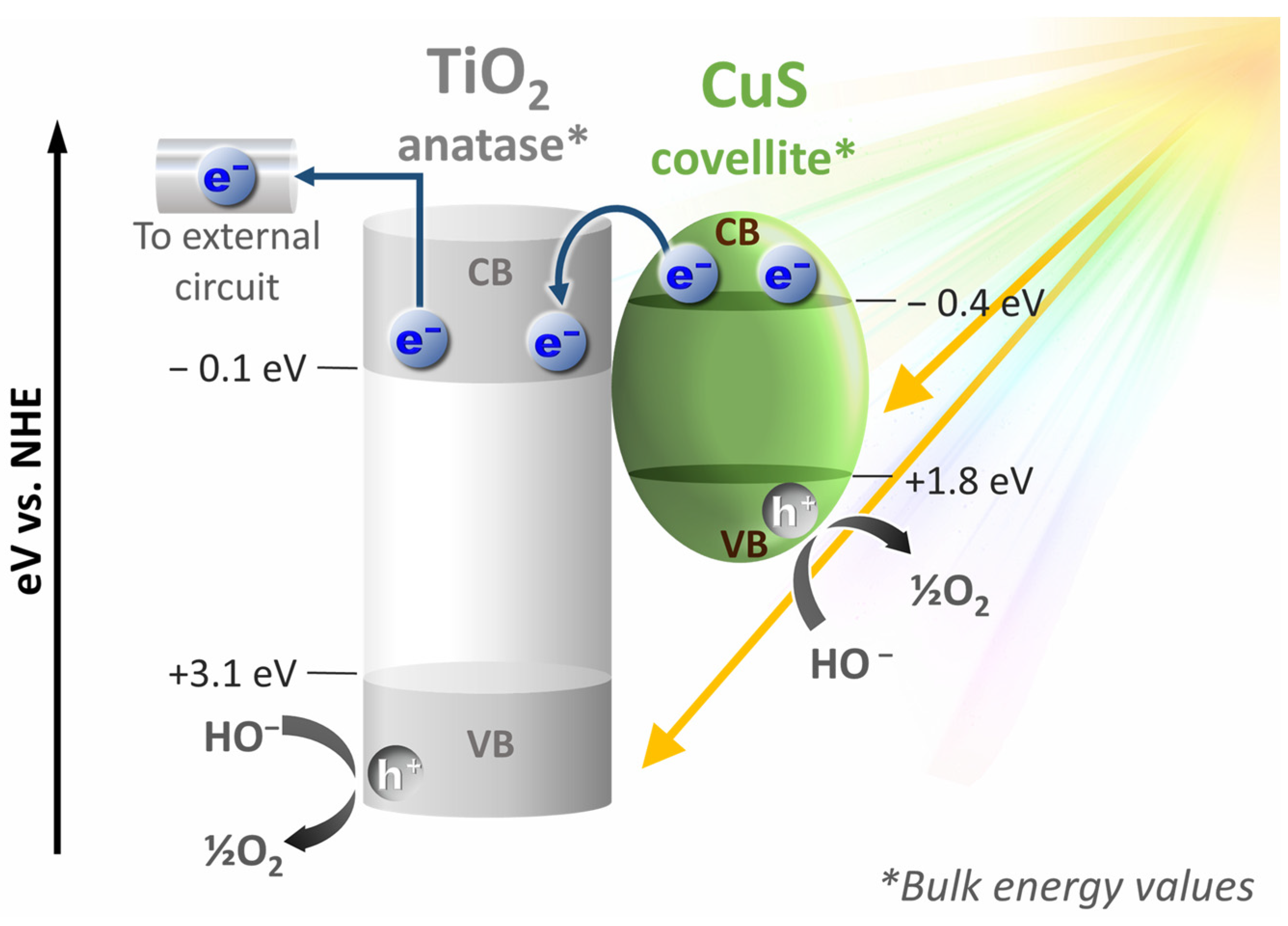Novel Synthesis Route of Plasmonic CuS Quantum Dots as Efficient Co-Catalysts to TiO2/Ti for Light-Assisted Water Splitting
Abstract
:1. Introduction
2. Experiments
2.1. Material Synthesis
2.2. Material Characterization
2.3. Photoelectrochemical Assays
3. Results and Discussion
3.1. Photoanode Engineering
3.2. Photoanode PEC Properties
4. Conclusions
Supplementary Materials
Author Contributions
Funding
Data Availability Statement
Acknowledgments
Conflicts of Interest
References
- Chaguetmi, S.; Achour, S.; Mouton, L.; Decorse, P.; Nowak, S.; Costentin, C.; Mammeri, F.; Ammar, S. TiO2 nanofibers supported on Ti sheets prepared by hydrothermal corrosion: Effect of the microstructure on their photochemical and photoelectrochemical properties. RSC Adv. 2015, 5, 95038–95046. [Google Scholar] [CrossRef]
- Lianos, P. Review of recent trends in photoelectrocatalytic conversion of solar energy to electricity and hydrogen. Appl. Catal. B Environ. 2017, 210, 235–254. [Google Scholar] [CrossRef]
- Egerton, T.A. Does photoelectrocatalysis by TiO2 work? J. Chem. Technol. Biotechnol. 2011, 86, 1024–1031. [Google Scholar] [CrossRef]
- Tsao, C.-W.; Fang, M.-J.; Hsu, Y.-J. Modulation of interfacial charge dynamics of semiconductor heterostructures for advanced photocatalytic applications. Coord. Chem. Rev. 2021, 438, 213876. [Google Scholar] [CrossRef]
- Lettieri, S.; Pavone, M.; Fioravanti, A.; Amato, L.S.; Maddalena, P. Charge Carrier Processes and Optical Properties in TiO2 and TiO2-Based Heterojunction Photocatalysts: A Review. Materials 2021, 14, 1645. [Google Scholar] [CrossRef] [PubMed]
- Marcus, R.A. On the theory of electron-transfer reactions. VI. Unified treatment for homogeneous and electrode reactions. J. Chem. Phys. 1965, 43, 679–701. [Google Scholar] [CrossRef]
- Gao, Y.Q.; Marcus, R.A. On the theory of electron transfer reactions at semiconductor/liquid interfaces. II. A free electron model. J. Chem. Phys. 2000, 113, 6351–6360. [Google Scholar] [CrossRef]
- Tvrdy, K.; Frantsuzov, P.A.; Kamat, P.V. Photoinduced electron transfer from semiconductor quantum dots to metal oxide nanoparticles. Proc. Natl. Acad. Sci. USA 2010, 108, 29–34. [Google Scholar] [CrossRef]
- Moridon, S.N.F.; Arifin, K.; Yunus, R.M.; Minggu, L.J.; Kassim, M.B. Photocatalytic water splitting performance of TiO2 sensitized by metal chalcogenides: A review. Ceram. Int. 2022, 48, 5892–5907. [Google Scholar] [CrossRef]
- Mamiyev, Z.; Balayeva, N.O. Metal Sulfide Photocatalysts for Hydrogen Generation: A Review of Recent Advances. Catalysts 2022, 12, 1316. [Google Scholar] [CrossRef]
- Keimer, B.; Moore, J.E. The physics of quantum materials. Nat. Phys. 2017, 13, 1045–1055. [Google Scholar] [CrossRef]
- Chaguetmi, S.; Mammeri, F.; Pasut, M.; Nowak, S.; Lecoq, H.; Decorse, P.; Costentin, C.; Achour, S.; Ammar, S. Synergetic effect of CdS quantum dots and TiO2 nanofibers for photoelectrochemical hydrogen generation. J. Nanopart. Res. 2013, 15, 2140. [Google Scholar] [CrossRef]
- Khatamian, M.; Oskoui, M.S.; Haghighi, M.; Darbandi, M. Visible-light response photocatalytic water splitting over CdS/TiO2 and CdS-TiO2/metalosilicate composites. Int. J. Energy Res. 2014, 38, 1712–1726. [Google Scholar] [CrossRef]
- Manchwari, S.; Khatter, J.; Chauhan, R. Enhanced photocatalytic efficiency of TiO2/CdS nanocomposites by manipulating CdS suspension on TiO2 nanoparticles. Inorg. Chem. Commun. 2022, 146, 110082. [Google Scholar] [CrossRef]
- Nguyen, V.N.; Doan, M.T.; Nguyen, M.V. Photoelectrochemical water splitting properties of CdS/TiO2 nanofibers-based photoanode. J. Mater. Sci. Mater. Electron. 2019, 30, 926–932. [Google Scholar] [CrossRef]
- Shen, J.; Meng, Y.; Xin, G. CdS/TiO2 nanotubes hybrid as visible light driven photocatalyst for water splitting. Rare Met. 2011, 30, 280–283. [Google Scholar] [CrossRef]
- Li, C.; Yuan, J.; Han, B.; Jiang, L.; Shangguan, W. TiO2 nanotubes incorporated with CdS for photocatalytic hydrogen production from splitting water under visible light irradiation. Int. J. Hydrogen Energy 2010, 35, 7073–7079. [Google Scholar] [CrossRef]
- Sharma, K.; Hasija, V.; Malhotra, M.; Verma, P.K.; Khan, A.A.P.; Thakur, S.; Van Le, Q.; Quang, H.H.P.; Nguyen, V.-H.; Singh, P.; et al. A review of CdS-based S-scheme for photocatalytic water splitting: Synthetic strategy and identification techniques. Int. J. Hydrogen Energy 2024, 52, 804–818. [Google Scholar] [CrossRef]
- Varmazyari, A.; Taghizadehghalehjoughi, A.; Sevim, C.; Baris, O.; Eser, G.; Yildirim, S.; Hacimuftuoglu, A.; Buha, A.; Wallace, D.R.; Tsatsakis, A.; et al. Cadmium sulfide-induced toxicity in the cortex and cerebellum: In vitro and in vivo studies. Toxicol. Rep. 2020, 7, 637–648. [Google Scholar] [CrossRef]
- Hossain, S.T.; Mukherjee, S.K. Toxicity of cadmium sulfide (CdS) nanoparticles against Escherichia coli and HeLa cells. J. Hazard. Mater. 2013, 260, 1073–1082. [Google Scholar] [CrossRef] [PubMed]
- Mahan, N.K.; Hassan, M.A.M.; Mohammed, A.H.; Khalee, R.I. Neuronal Toxicity of CdS Nanoparticles Prepared by Laser Ablation and their Effect on Liver. Mater. Sci. Forum 2021, 1039, 537–556. [Google Scholar] [CrossRef]
- Chaguetmi, S.; Chaperman, L.; Nowak, S.; Schaming, D.; Lau-Truong, S.; Decorse, P.; Beaunier, P.; Costentin, C.; Mammeri, F.; Achour, S.; et al. Photoelectrochemical properties of ZnS- and CdS-TiO2 nanostructured photocatalysts: Aqueous sulfidation as a smart route to improve catalyst stability. J. Photochem. Photobiol. A Chem. 2018, 356, 489–501. [Google Scholar] [CrossRef]
- Liu, Q.; Liu, Y.; Lei, T.; Tan, Y.; Wu, H.; Li, J. Preparation and characterization of nanostructured titanate bioceramic coating by anodization–hydrothermal method. Appl. Surf. Sci. 2015, 328, 279–286. [Google Scholar] [CrossRef]
- Wang, H.; Lai, Y.-K.; Zheng, R.-Y.; Bian, Y.; Lin, C.-J.; Zhang, K.-Q. Tuning the surface microstructure of titanate coatings on titanium implants for enhancing bioactivity of implants. Int. J. Nanomed. 2015, 10, 3887–3896. [Google Scholar] [CrossRef] [PubMed]
- Wu, Y.; Long, M.; Cai, W.; Dai, S.; Chen, C.; Wu, D.; Bai, J. Preparation of photocatalytic anatase nanowire films by in situ oxidation of titanium plate. Nanotechnology 2009, 20, 185703–185711. [Google Scholar] [CrossRef] [PubMed]
- Feng, T.; Yam, F. The influence of hydrothermal treatment on TiO2 nanostructure films transformed from titanates and their photoelectrochemical water splitting properties. Surf. Interfaces 2023, 38, 102767. [Google Scholar] [CrossRef]
- Xu, Y.; Zhang, M.; Zhang, M.; Lv, J.; Jiang, X.; He, G.; Song, X.; Sun, Z. Controllable hydrothermal synthesis, optical and photocatalytic properties of TiO2 nanostructures. Appl. Surf. Sci. 2014, 315, 299–306. [Google Scholar] [CrossRef]
- van Dillen, A.; Terörde, R.J.; Lensveld, D.J.; Geus, J.W.; de Jong, K.P. Synthesis of supported catalysts by impregnation and drying using aqueous chelated metal complexes. J. Catal. 2003, 216, 257–264. [Google Scholar] [CrossRef]
- Campelo, J.M.; Luna, D.; Luque, R.; Marinas, J.M.; Romero, A.A. Sustainable Preparation of Supported Metal Nanoparticles and Their Applications in Catalysis. ChemSusChem 2009, 2, 18–45. [Google Scholar] [CrossRef]
- Jang, J.S.; Kim, H.G.; Lee, J.S. Heterojunction semiconductors: A strategy to develop efficient photocatalytic materials for visible light water splitting. Catal. Today 2012, 185, 270–277. [Google Scholar] [CrossRef]
- Isik, M.; Terlemezoglu, M.; Gasanly, N.; Parlak, M. Structural, morphological and temperature-tuned bandgap characteristics of CuS nano-flake thin films. Phys. E Low-Dimens. Syst. Nanostruct. 2022, 144, 115407. [Google Scholar] [CrossRef]
- Mohammed, K.A.; Ahmed, S.M.; Mohammed, R.Y. Investigation of structure, optical, and electrical properties of CuS thin Films by CBD technique. Crystals 2020, 10, 684. [Google Scholar] [CrossRef]
- Kwon, Y.-T.; Lim, G.-D.; Kim, S.; Ryu, S.H.; Lim, H.-R.; Choa, Y.-H. Effect of localized surface plasmon resonance on dispersion stability of copper sulfide nanoparticles. Appl. Surf. Sci. 2019, 477, 204–210. [Google Scholar] [CrossRef]
- Nishi, H.; Asami, K.; Tatsuma, T. CuS nanoplates for LSPR sensing in the second biological optical window. Opt. Mater. Express 2016, 6, 1043–1048. [Google Scholar] [CrossRef]
- Agrawal, A.; Cho, S.H.; Zandi, O.; Ghosh, S.; Johns, R.W.; Milliron, D.J. Localized Surface Plasmon Resonance in Semiconductor Nanocrystals. Chem. Rev. 2018, 118, 3121–3207. [Google Scholar] [CrossRef] [PubMed]
- Comin, A.; Manna, L. New materials for tunable plasmonic colloidal nanocrystals. Chem. Soc. Rev. 2014, 43, 3957–3975. [Google Scholar] [CrossRef] [PubMed]
- Fu, W.; Liu, M.; Xue, F.; Wang, X.; Diao, Z.; Guo, L. Facile polyol synthesis of CuS nanocrystals with a hierarchical nanoplate structure and their application for electrocatalysis and photocatalysis. RSC Adv. 2016, 6, 80361–80367. [Google Scholar] [CrossRef]
- El-Gendy, R.A.; El-Bery, H.M.; Farrag, M.; Fouad, D.M. Metal chalcogenides (CuS or MoS2)-modified TiO2 as highly efficient bifunctional photocatalyst nanocomposites for green H2 generation and dye degradation. Sci. Rep. 2023, 13, 7994. [Google Scholar] [CrossRef] [PubMed]
- Ye, H.; Tang, A.; Hou, Y.; Yang, C.; Teng, F. Tunable near-infrared localized surface plasmon resonances of heterostructured Cu1.94S-ZnS nanocrystals. Opt. Mater. Express 2014, 4, 220. [Google Scholar] [CrossRef]
- Ding, Y.; Lin, R.; Xiong, S.; Zhu, Y.; Yu, M.; Duan, X. The Effect of Copper Sulfide Stoichiometric Coefficient and Morphology on Electrochemical Performance. Molecules 2023, 28, 2487. [Google Scholar] [CrossRef]
- Heydari, H.; Moosavifard, S.E.; Shahraki, M.; Elyasi, S. Facile synthesis of nanoporous CuS nanospheres for high-performance supercapacitor electrodes. J. Energy Chem. 2017, 26, 762–767. [Google Scholar] [CrossRef]
- Naveed, M.; Younas, W.; Zhu, Y.; Rafai, S.; Zhao, Q.; Tahir, M.; Mushtaq, N.; Cao, C. Template free and facile microwave-assisted synthesis method to prepare mesoporous copper sulfide nanosheets for high-performance hybrid supercapacitor. Electrochim. Acta 2019, 319, 49–60. [Google Scholar] [CrossRef]
- Savarimuthu, I.; Susairaj, M.J.A.M. CuS Nanoparticles Trigger Sulfite for Fast Degradation of Organic Dyes under Dark Conditions. ACS Omega 2022, 7, 4140–4149. [Google Scholar] [CrossRef]
- Ahmad, N.; Alshehri, A.; Ahmad, I.; Shkir, M.; Hasan, P.; Melaibari, A.A. In doping effect on the structural, morphological, optical and enhanced antimicrobial activity of facilely synthesized novel CuS nanostructures. Surf. Interfaces 2021, 27, 101536. [Google Scholar] [CrossRef]
- Rudra, S.; Bhar, M.; Mukherjee, P. Post-synthetic modification of semiconductor nanoparticles can generate lanthanide luminophores and modulate the electronic properties of preformed nanoparticles. 4open 2023, 6, 8. [Google Scholar] [CrossRef]
- Fiévet, F.; Ammar-Merah, S.; Brayner, R.; Chau, F.; Giraud, M.; Mammeri, F.; Peron, J.; Piquemal, J.-Y.; Sicard, L.; Viau, G. The polyol process: A unique method for easy access to metal nanoparticles with tailored sizes, shapes and compositions. Chem. Soc. Rev. 2018, 47, 5187–5233. [Google Scholar] [CrossRef] [PubMed]
- Longo, A.V.; Notebaert, B.; Gaceur, M.; Patriarche, G.; Sciortino, A.; Cannas, M.; Messina, F.; von Bardeleben, H.J.; Battaglini, N.; Ammar, S. Photo-Activated Phosphorescence of Ultrafine ZnS:Mn Quantum Dots: On the Lattice Strain Contribution. J. Phys. Chem. C 2022, 126, 1531–1541. [Google Scholar] [CrossRef]
- Hussain, S.; Patil, S.A.; Memon, A.A.; Vikraman, D.; Naqvi, B.A.; Jeong, S.H.; Kim, H.-S.; Kim, H.-S.; Jung, J. CuS/WS2 and CuS/MoS2 heterostructures for high performance counter electrodes in dye-sensitized solar cells. Sol. Energy 2018, 171, 122–129. [Google Scholar] [CrossRef]
- Karikalan, N.; Karthik, R.; Chen, S.-M.; Karuppiah, C.; Elangovan, A. Sonochemical Synthesis of Sulfur Doped Reduced Graphene Oxide Supported CuS Nanoparticles for the Non-Enzymatic Glucose Sensor Applications. Sci. Rep. 2017, 7, 2494. [Google Scholar] [CrossRef]
- Biesinger, M.C.; Hart, B.R.; Polack, R.; Kobe, B.A.; Smart, R.S. Analysis of mineral surface chemistry in flotation separation using imaging XPS. Miner. Eng. 2007, 20, 152–162. [Google Scholar] [CrossRef]
- Tang, A.; Qu, S.; Li, K.; Hou, Y.; Teng, F.; Cao, J.; Wang, Y.; Wang, Z. One-pot synthesis and self-assembly of colloidal copper(I) sulfide nanocrystals. Nanotechnology 2010, 21, 285602. [Google Scholar] [CrossRef] [PubMed]
- Biesinger, M.C. Advanced Analysis of Copper X-ray Photoelectron (XPS) Spectra. Surf. Interface Anal. 2017, 49, 1325–1334. [Google Scholar] [CrossRef]
- Zhu, L.; Lu, Q.; Lv, L.; Wang, Y.; Hu, Y.; Deng, Z.; Lou, Z.; Hou, Y.; Teng, F. Ligand-free rutile and anatase TiO2 nanocrystals as electron extraction layers for high performance inverted polymer solar cells. RSC Adv. 2017, 7, 20084–20092. [Google Scholar] [CrossRef]
- Marschall, R. Semiconductor composites: Strategies for enhancing charge carrier separation to improve photocatalytic activity. Adv. Funct. Mater. 2014, 24, 2421–2440. [Google Scholar] [CrossRef]
- Huerta-Flores, A.M.; Torres-Martínez, L.M.; Moctezuma, E.; Singh, A.P.; Wickman, B. Green synthesis of earth-abundant metal sulfides (FeS2, CuS, and NiS2) and their use as visible-light active photocatalysts for H2 generation and dye removal. J. Mater. Sci. Mater. Electron. 2018, 29, 11613–11626. [Google Scholar] [CrossRef]
- Chandra, M.; Bhunia, K.; Pradhan, D. Controlled Synthesis of CuS/TiO2 Heterostructured Nanocomposites for Enhanced Photocatalytic Hydrogen Generation through Water Splitting. Inorg. Chem. 2018, 57, 4524–4533. [Google Scholar] [CrossRef] [PubMed]
- Jia, S.; Li, X.; Zhang, B.; Yang, J.; Zhang, S.; Li, S.; Zhang, Z. TiO2/CuS heterostructure nanowire array photoanodes toward water oxidation: The role of CuS. Appl. Surf. Sci. 2019, 463, 829–837. [Google Scholar] [CrossRef]
- Liu, J.; Sun, X.; Fan, Y.; Yu, Y.; Li, Q.; Zhou, J.; Gu, H.; Shi, K.; Jiang, B. P-N Heterojunction Embedded CuS/TiO2 Bifunctional Photocatalyst for Synchronous Hydrogen Production and Benzylamine Conversion. Small 2024, 20, e2306344. [Google Scholar] [CrossRef]
- Wang, Q.; An, N.; Bai, Y.; Hang, H.; Li, J.; Lu, X.; Liu, Y.; Wang, F.; Li, Z.; Lei, Z. High photocatalytic hydrogen production from methanol aqueous solution using the photocatalysts CuS/TiO2. Int. J. Hydrogen Energy 2013, 38, 10739–10745. [Google Scholar] [CrossRef]
- Lutterotti, L.; Matthies, S.; Wenk, H.R. MAUD: A friendly Java program for material analysis using diffraction. IUCr Newsl. Comm. Powder Diffr. 1999, 21, 14–15. [Google Scholar]
- Yu, B.; Meng, F.; Zhou, T.; Fan, A.; Khan, M.W.; Wu, H.; Liu, X. Construction of hollow TiO2/CuS nanoboxes for boosting full-spectrum driven photocatalytic hydrogen evolution and environmental remediation. Ceram. Int. 2021, 47, 8849–8858. [Google Scholar] [CrossRef]
- Zhao, X.; Zhao, K.; Su, J.; Sun, L. TiO2/CuS core-shell nanorod arrays with aging-induced photoelectric conversion enhancement effect. Electrochem. Commun. 2020, 111, 106648. [Google Scholar] [CrossRef]
- Huang, Z.; Wen, Z.X.; Xiao, X. Photoelectrochemical Properties of CuS-TiO2 Composite Coating Electrode and Its Preparation via Electrophoretic Deposition. J. Electrochem. Soc. 2011, 158, H1247–H1251. [Google Scholar] [CrossRef]
- Tang, Y.; Chai, Y.; Liu, X.; Li, L.; Yang, L.; Liu, P.; Zhou, Y.; Ju, H.; Cheng, Y. A photoelectrochemical aptasensor constructed with core-shell CuS-TiO2 heterostructure for detection of microcystin-LR. Biosens. Bioelectron. 2018, 117, 224–231. [Google Scholar] [CrossRef] [PubMed]
- Wang, Y.; Bai, L.; Wang, Y.; Qina, D.; Shan, D.; Lu, X. Ternary nanocomposites of Au/CuS/TiO2 for ultrasensitive photoelectrochemical non-enzymatic glucose sensor. Analyst 2018, 143, 1699–1704. [Google Scholar] [CrossRef] [PubMed]
- Ngaotrakanwiwat, P.; Heawphet, P.; Rangsunvigit, P. Enhancement of photoelectrochemical cathodic protection of copper in Marine Condition by Cu-Doped TiO2. Catalysts 2020, 10, 146. [Google Scholar] [CrossRef]
- Liu, W.; Ji, H.; Wang, J.; Zheng, X.; Lai, J.; Ji, J.; Li, T.; Ma, Y.; Li, H.; Zhao, S.; et al. Synthesis and Photo-Response of CuS thin films by an in situ multi-deposition process at room temperature: A Facile & eco-friendly approach. NANO Brief Rep. Rev. 2015, 10, 1550032. [Google Scholar]









| Binding Energy (eV) | Content (at.- %) | |||||
|---|---|---|---|---|---|---|
| TiO2/Ti | CuS-TiO2/Ti | CuS | TiO2/Ti | CuS-TiO2/Ti | CuS | |
| C 1s (C-C/C-H) | 284.8 | 284.8 | 284.8 | 17.6 | 19.0 | 13.4 |
| C 1s (C-O) | 286.4 | 286.5 | 286.5 | 3.9 | 4.9 | 5.9 |
| C 1s (C=O) | 288.8 | 288.5 | 289.1 | 2.0 | 2.0 | 2.0 |
| Cu LMM | - | 565.3 | 568.9 | - | - | - |
| Cu 2p | - | 933.6 | 932.2 | - | 2.9 | 23.2 |
| N 1s | 400.1 | 399.7 | 399.8 | 0.4 | 0.6 | 4.2 |
| O 1s | 529.8 | 530.0 | 532.2 | 53.7 | 49.5 | 23.7 |
| S2− 2p | - | 162.2 | 162.5 | - | 1.7 | 21.6 |
| SO42− 2p | - | 168.5 | 168.9 | - | 0.4 | 5.8 |
| Ti 2p | 458.5 | 458.6 | - | 22.4 | 19.0 | - |
Disclaimer/Publisher’s Note: The statements, opinions and data contained in all publications are solely those of the individual author(s) and contributor(s) and not of MDPI and/or the editor(s). MDPI and/or the editor(s) disclaim responsibility for any injury to people or property resulting from any ideas, methods, instructions or products referred to in the content. |
© 2024 by the authors. Licensee MDPI, Basel, Switzerland. This article is an open access article distributed under the terms and conditions of the Creative Commons Attribution (CC BY) license (https://creativecommons.org/licenses/by/4.0/).
Share and Cite
Chaperman, L.; Chaguetmi, S.; Deng, B.; Gam-Derrouich, S.; Nowak, S.; Mammeri, F.; Ammar, S. Novel Synthesis Route of Plasmonic CuS Quantum Dots as Efficient Co-Catalysts to TiO2/Ti for Light-Assisted Water Splitting. Nanomaterials 2024, 14, 1581. https://doi.org/10.3390/nano14191581
Chaperman L, Chaguetmi S, Deng B, Gam-Derrouich S, Nowak S, Mammeri F, Ammar S. Novel Synthesis Route of Plasmonic CuS Quantum Dots as Efficient Co-Catalysts to TiO2/Ti for Light-Assisted Water Splitting. Nanomaterials. 2024; 14(19):1581. https://doi.org/10.3390/nano14191581
Chicago/Turabian StyleChaperman, Larissa, Samiha Chaguetmi, Bingbing Deng, Sarra Gam-Derrouich, Sophie Nowak, Fayna Mammeri, and Souad Ammar. 2024. "Novel Synthesis Route of Plasmonic CuS Quantum Dots as Efficient Co-Catalysts to TiO2/Ti for Light-Assisted Water Splitting" Nanomaterials 14, no. 19: 1581. https://doi.org/10.3390/nano14191581
APA StyleChaperman, L., Chaguetmi, S., Deng, B., Gam-Derrouich, S., Nowak, S., Mammeri, F., & Ammar, S. (2024). Novel Synthesis Route of Plasmonic CuS Quantum Dots as Efficient Co-Catalysts to TiO2/Ti for Light-Assisted Water Splitting. Nanomaterials, 14(19), 1581. https://doi.org/10.3390/nano14191581







